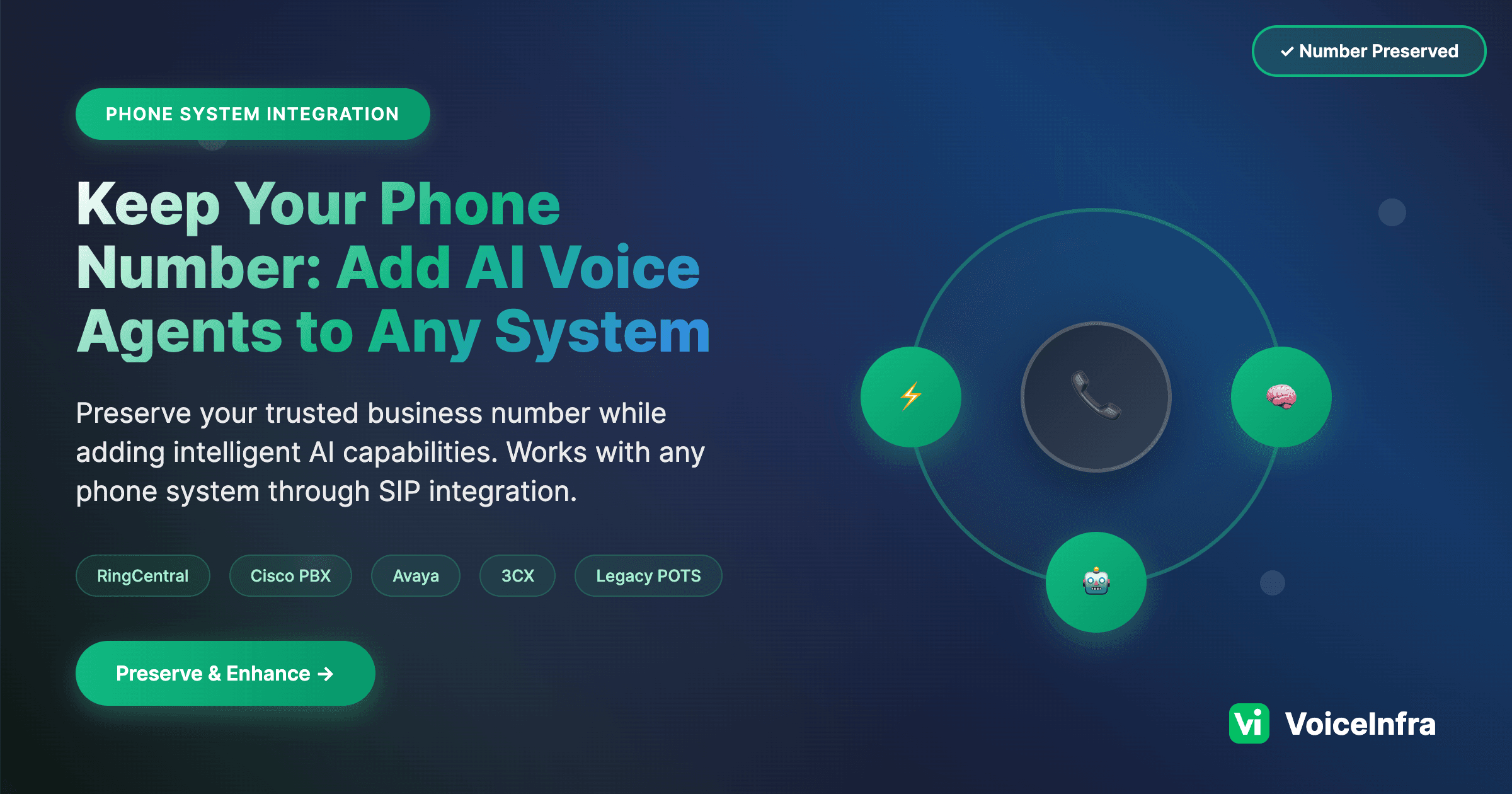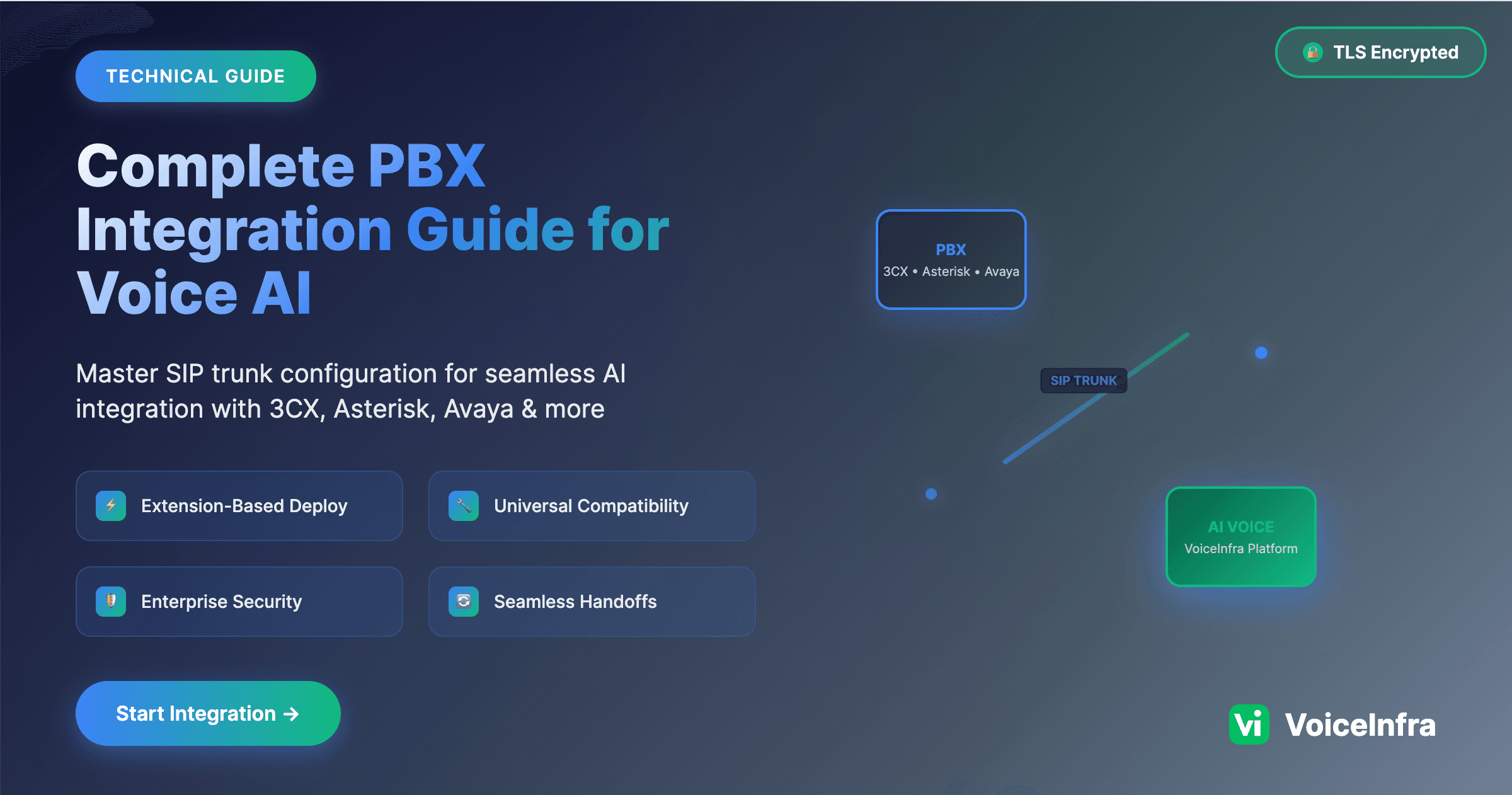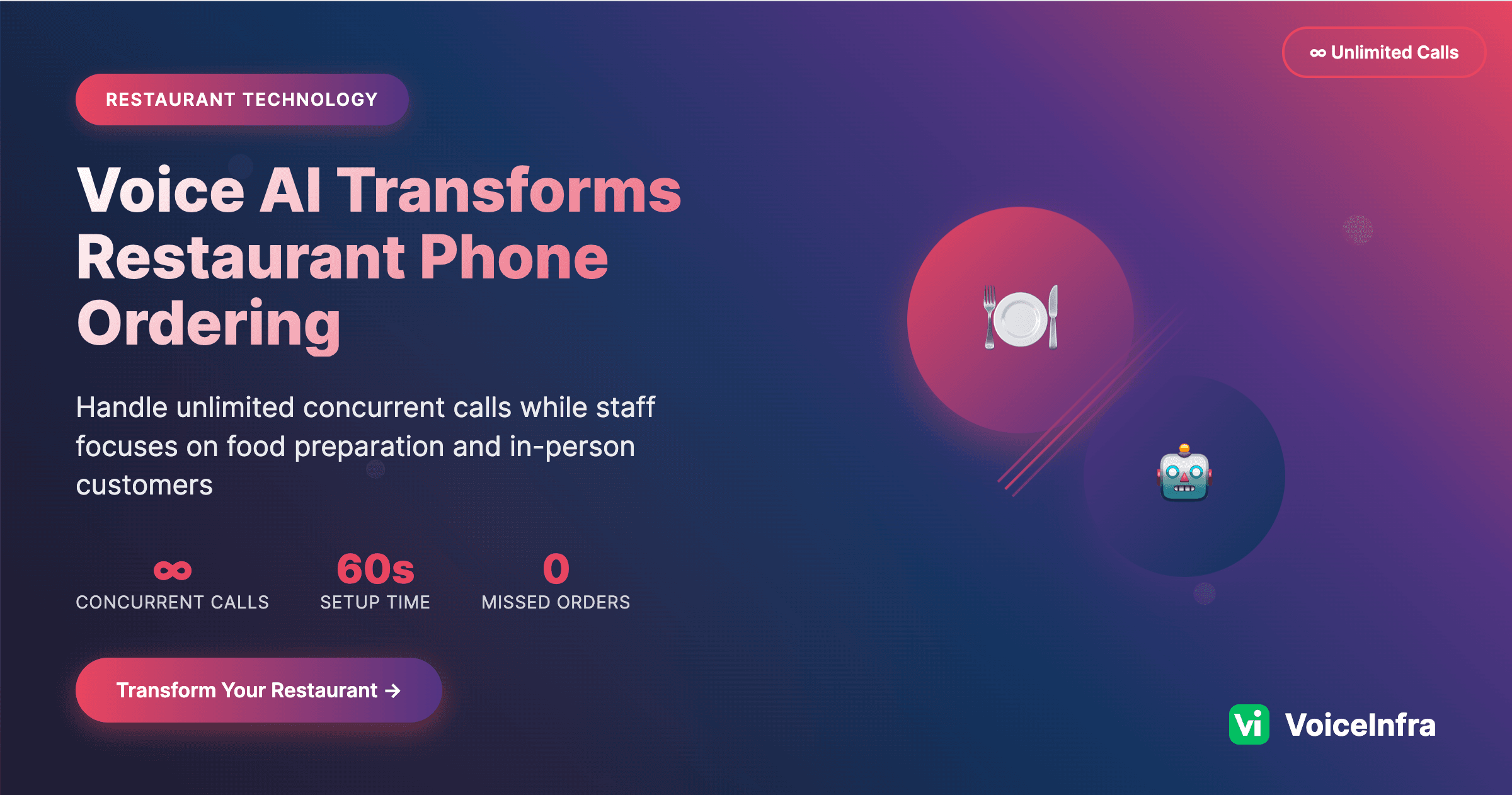Your business phone number represents years of marketing investment and customer familiarity. Changing it to implement AI voice agents means updating signage, business cards, directories, and risking lost customer connections.
SIP (Session Initiation Protocol) technology provides a solution: integrate AI providers with your existing phone infrastructure without changing your number. This technical guide covers implementation methods for different phone system types.
The integration preserves your existing number while adding access to leading AI providers through intelligent call routing and system layering.
Why Preserve Your Existing Number
Changing your business phone number requires updating marketing materials, business cards, directories, and online listings on your website. The process typically costs between 2,000 and 8,000 USD and risks losing customer connections during the transition.
SIP integration preserves your existing number while adding AI capabilities, eliminating these costs, and maintaining customer familiarity.
Understanding Your Current Phone Setup
Virtual/DID Numbers (Cloud-Based Systems)
What They Are:
Numbers hosted by providers like RingCentral, Vonage, or 8x8
Route calls over the internet to your devices
Most common for modern businesses (65% adoption rate)
AI Integration Method:
Direct SIP trunk configuration in the provider portal
Call routing rules modification
No additional hardware required
How to Identify:
You manage settings through the web portal
Calls work when the internet is down, but phone service continues
A monthly subscription includes the number
Physical Landlines (POTS Lines)
What They Are:
Traditional copper wire connections from the phone company
POTS (Plain Old Telephone Service) with analog signaling
Direct physical connection to your location
Still used by 35% of small businesses
Technical Components:
FXS (Foreign Exchange Station): Provides dial tone and power to analog phones
FXO (Foreign Exchange Office): Connects to PSTN and receives calls
Analog signaling over copper infrastructure
AI Integration Method:
ATA (Analog Telephone Adapter) converts analog to digital SIP
Call forwarding routes to the AI system when configured
Maintains the existing number and physical POTS connection
FXO port on the ATA connects to the existing phone line
How to Identify:
Physical phone line enters your building
Works during power outages
Billed by a traditional phone company
Analog phones connect directly to wall jacks
Business PBX Systems
IP-PBX (Modern):
Cisco, Avaya, Mitel, 3CX systems, and their alternatives
Already use the SIP protocol internally.
Direct integration with AI voice agents
Legacy PBX:
Older Nortel, Panasonic, or analog systems
Requires a SIP gateway for AI integration
Can maintain all existing extensions
Hybrid Systems:
Mix of old and new technology
Gradual migration to AI-enhanced features
Preserve investment in existing equipment
SIP Integration: The Bridge Technology
What SIP Actually Does
Session Initiation Protocol Explained Simply: Think of SIP as a universal translator for phone systems. Just like how email works between Gmail, Outlook, and Yahoo, SIP lets different phone technologies talk to each other.
The Magic of SIP:
Your existing number stays exactly the same
Calls route intelligently between systems
AI agents appear as another "extension" to your phone system
Seamless handoffs between AI and human agents
How SIP Preserves Your Number
SIP acts as a routing layer between your existing number and phone system. Calls to your number route through SIP to either AI providers or human staff, while maintaining the same customer-facing number.
Call Flow:
Customer → Your Phone Number → SIP Router → AI Provider OR Your Staff
You retain number ownership and carrier relationships; SIP only changes internal call routing.
Integration Methods by Phone System Type
Virtual/VoIP Numbers
Configuration Process:
VoiceInfra Setup:
Import Twilio numbers: Provide Account SID and Auth Token
Import WhatsApp Business: Provide Meta Developer App Auth Token
Enter number in E.164 format (+1234567890)
Provider Portal Configuration:
Add SIP trunk pointing to VoiceInfra endpoint
Configure call routing rules
Set fallback to the existing system
Physical Landlines (POTS)
What You'll Need:
ATA (Analog Telephone Adapter): 50 − 150 USD (purchased separately)
Ethernet connection for internet access
Integration Process:
Connect your landline to the ATA FXO port
Configure the ATA with VoiceInfra SIP endpoint settings
Set up call forwarding through your phone company
Test AI routing and fallback to the original system
ATA Selection:
Business-grade models offer better reliability
Feature-rich devices provide more configuration options
Enterprise models include advanced routing capabilities
PBX Systems
IP-PBX Integration:
Add VoiceInfra as a SIP trunk provider
Configure routing rules in the admin panel
Set up an AI agent as an extension
Legacy PBX Integration:
Install the SIP gateway device
Connect the gateway to the trunk ports
Configure routing through the gateway
Custom SIP Trunk Configuration
VoiceInfra SIP Configuration Options:
1. Basic Information
Enter phone number in E.164 format (+1234567890)
For extensions: Use format 1001@pbx.company.com
Assign a descriptive name for identification
2. Inbound Configuration
Choose inbound trunk type based on security requirements:
a) Minimal Inbound Trunk
Accepts all inbound calls to the configured number
Simplest configuration for basic AI agent deployments
Best for: Single-purpose AI agents with no security restrictions
b) Phone Numbers and IPs Specific
Restricts calls to specific caller numbers and IP ranges
Enhanced security through allowlisting
Example configuration:
Allowed numbers: +11111111, +22222222
Allowed IP range: 1.1.1.0/24
Best for: Controlled environments with known callers
c) Auth/Pass Protected
Requires username/password authentication
Highest security level for enterprise deployments
Integrates with existing SIP trunk provider credentials
Best for: Enterprise deployments with strict security requirements
3. Outbound Configuration
Configure these essential parameters for two-way communication:
Outbound SIP URI: Your PBX's SIP endpoint
Outbound Auth Username: SIP authentication username
Outbound Auth Password: SIP authentication password
SIP Transport Protocol: Choose optimal protocol:
TCP: Reliable, standard choice for most deployments
UDP: Faster with less overhead, good for high-volume
TLS: Encrypted transport, most secure option
AUTO: Platform automatically selects optimal protocol
Implementation Checklist
Technical Requirements:
Stable internet connection (100kbps per concurrent call)
Access to phone system admin settings
Current phone system documentation
Implementation Steps:
VoiceInfra Account Setup
Create an account and configure the AI agent
Upload business information and FAQs
Choose a voice provider and personality settings
Phone System Integration
Configure SIP trunk or ATA device
Set up call routing rules
Test AI responses and escalation procedures
Testing and Deployment
Verify audio quality and call flow
Test failover and backup procedures
Gradually increase the AI call handling percentage
How VoiceInfra Upgrades Different Business Types
Restaurants with Legacy Phone Systems
Common Challenge: Family restaurants with 20+ year old landline numbers fear losing customer recognition by upgrading to modern phone systems.
VoiceInfra Solution:
Connects to existing landline through simple SIP configuration
AI providers (OpenAI, Anthropic, Groq) handle reservation calls while preserving the trusted number
Intelligent routing sends complex dietary questions to kitchen staff
24/7 availability without changing the customer contact experience
Why It's Easy to Upgrade: Your existing phone infrastructure stays exactly the same. VoiceInfra's platform connects your phone system to leading AI providers through SIP routing; no hardware replacement needed.
Medical Practices with Enterprise PBX
Common Challenge: Healthcare practices worry that adding AI means replacing expensive PBX systems and risking HIPAA compliance issues.
VoiceInfra Solution:
Integrates directly with existing Cisco, Avaya, or Mitel PBX systems
HIPAA-compliant platform connects to AI providers for appointment scheduling and basic inquiries
Preserves all existing extensions and call flows
Seamless escalation to medical staff with full patient context
Why It's Easy to Upgrade: Modern PBX systems already speak SIP protocol. VoiceInfra connects as another SIP endpoint; your existing infrastructure gets access to leading AI providers without replacement.
Service Companies with Mixed Systems
Common Challenge: Home service businesses think unifying VoIP office phones, owner's landline, and field cell phones requires complex system overhauls.
VoiceInfra Solution:
Single platform connects all phone types to AI providers
Professional AI presence regardless of the underlying phone technology
Smart routing based on call urgency and technician availability
Unified customer experience across all contact methods
Why It's Easy to Upgrade: VoiceInfra works with any phone system that can forward calls or configure SIP routing. Your diverse phone setup gets unified access to leading AI providers through software integration.
Technical Requirements and Costs
Hardware Requirements by System Type
System Type | Hardware Needed | Cost Range (USD) |
Virtual/VoIP | None (software configuration) | $0 |
Physical Landlines | ATA device | 50 − 150 |
Legacy PBX | SIP gateway | 200 − 500 |
IP-PBX | None (SIP trunk configuration) | $0 |
Network Requirements
Bandwidth: 100kbps per concurrent call (200kbps recommended)
Latency: <150ms for optimal quality
Connection: Stable internet with QoS configuration
Cost Structure
VoiceInfra Platform:
Pay-as-you-go: $0.05 USD/minute + provider costs
Typical usage: 150 − 400 USD/month for 1,000 minutes
Enterprise plans: Custom pricing available
Advanced Configuration Options
Hybrid Human-AI Call Routing:
Intelligent call classification based on keywords
Time-based routing (AI after hours, humans during business)
Skill-based routing to appropriate team members
Queue management with AI handling overflow
Business Hours vs After-Hours Handling:
Automatic schedule detection and routing
Holiday and vacation schedule integration
Emergency escalation procedures
Voicemail integration with transcription
Multiple Location Management:
Centralized AI with location-specific information
Local number forwarding to unified system
Location-based routing and staff assignment
Unified reporting across all locations
Troubleshooting Common Issues
Call Quality Optimization
Common Audio Problems:
Echo or feedback during calls
Choppy or robotic voice quality
Delay or latency in responses
Background noise interference
Solutions:
Echo Issues: Configure echo cancellation in SIP settings
Quality Problems: Increase bandwidth allocation or upgrade the internet
Latency Issues: Choose a closer VoiceInfra server region
Noise Problems: Enable noise cancellation features
Network Optimization:
Configure QoS rules to prioritize voice traffic
Use wired connections instead of WiFi when possible
Monitor network performance during peak usage
Implement traffic shaping for consistent performance
Routing Problems and Solutions
Call Routing Issues:
Calls not reaching the AI agent
Incorrect escalation to human staff
Lost calls during handoffs
Inconsistent routing behavior
Diagnostic Steps:
Check SIP Registration: Verify connection to VoiceInfra servers
Review Routing Rules: Confirm configuration matches the intended flow
Test Call Paths: Make test calls to verify each routing scenario
Monitor Logs: Review call logs for error patterns
Common Fixes:
Update SIP credentials and server settings
Adjust routing rules for better call classification
Configure proper failover and backup procedures
Implement call recording for troubleshooting
Backup and Failover Options
System Redundancy:
Primary and backup SIP servers
Automatic failover to human staff
Local backup systems for internet outages
Mobile app integration for remote management
Disaster Recovery:
Cloud-based configuration backup
Rapid deployment to alternate locations
Emergency contact procedures
Business continuity planning
Monitoring and Alerts:
Real-time system health monitoring
Automatic alerts for service disruptions
Performance threshold notifications
Proactive maintenance scheduling
Getting Started
Trial Setup:
Sign up for VoiceInfra Pay-As-You-Go plan (0 USD to start, 10 USD free credit)
Configure the AI agent with your business information
Set up test routing with the existing number
Gradually increase AI handling based on performance
Support Resources:
Email: hello@voiceinfra.ai
Technical documentation and integration guides
Implementation assistance for Enterprise customers
Why VoiceInfra is Different
Unique Integration Capabilities
Multiple Number Import Methods:
Twilio Integration: Import existing Twilio numbers with just Account SID and Auth Token
WhatsApp Business API: Connect WhatsApp numbers using the Meta Developer App Auth Token
Extension Support: Configure PBX extensions (e.g., 1001@pbx.company.com) without new numbers
Custom SIP Trunks: Flexible inbound/outbound configuration with security options
Multi-Provider AI Access: Unlike competitors locked to single AI providers, VoiceInfra connects you to:
OpenAI GPT-4o Mini Realtime for reliability
Anthropic Claude for complex reasoning
Groq for ultra-fast responses
Google Gemini for multilingual support
True Infrastructure Preservation: Other platforms require you to change numbers, port services, or replace systems. VoiceInfra integrates with your existing setup, whether it's a 30-year landline, modern VoIP, or complex PBX infrastructure.
Compatible with Leading Business Phone Systems
VoIP Provider Integration
VoiceInfra seamlessly integrates with popular VoIP providers and their alternatives:
RingCentral and RingCentral alternatives like Nextiva, Dialpad, and OpenPhone
Vonage and Vonage alternatives, including Zoom Phone, GoTo Connect, and Phone.com
8x8, Ooma, and other cloud-based business phone systems
PBX System Compatibility
Works with enterprise PBX systems and their modern alternatives:
Cisco UCM and Cisco PBX alternatives like FreePBX, Grandstream, and Yealink systems
Avaya and Avaya alternatives, including Genesys, Nextiva, and cloud-first solutions
3CX and 3CX alternatives, such as Asterisk, FusionPBX, and other open-source options
Communication Platform Integration
Extends beyond traditional phone systems to modern communication platforms:
Twilio and Twilio alternatives like Bandwidth, Plivo, and Sinch for voice API integration
Microsoft Teams, Zoom Phone, and other UCaaS platforms through SIP trunk integration
Ready to keep your trusted phone number while adding 24/7 AI assistance?
Start Your Free Trial with VoiceInfra →
VoiceInfra's SIP integration technology preserves your existing phone number, carrier relationships, and system investments while adding enterprise-grade AI voice agents in under 60 seconds. No porting, no downtime, no customer confusion; just instant AI enhancement of your current phone system.
Frequently Asked Questions
Will I lose my phone number when adding AI voice agents?
No. VoiceInfra is a platform that connects your existing phone system to AI providers through SIP technology. Your number, carrier, and phone system stay the same; we just add AI capabilities through intelligent routing.
What AI providers does VoiceInfra connect to?
VoiceInfra connects to multiple leading AI providers, including OpenAI GPT-4o Mini Realtime, Anthropic Claude, Google Gemini, and Groq. This multi-provider approach gives you access to the best AI models rather than being locked to a single provider.
How do I import my existing Twilio or WhatsApp numbers?
For Twilio numbers: Simply provide your Account SID and Auth Token, and VoiceInfra automatically configures webhook routing. For WhatsApp Business: Enter your WhatsApp Business phone number and Meta Developer App Auth Token to enable voice integration.
What's the difference between the SIP trunk security options?
VoiceInfra offers three security levels: Minimal Inbound Trunk (accepts all calls, most straightforward setup), Phone Numbers and IPs Specific (restricts to allowlisted callers and IP ranges), and Auth/Pass Protected (requires username/password authentication for enterprise security).
Can I use PBX extensions instead of getting new phone numbers?
Yes. VoiceInfra supports extension configuration (e.g., 1001@pbx.company.com) so you can deploy AI agents as extensions within your existing PBX system without provisioning new phone numbers.
What happens if my internet goes down?
Your existing phone system continues working normally. VoiceInfra integrates as an overlay, so calls automatically route to your original system if internet connectivity is lost. For POTS lines with ATA devices, the original landline remains functional.
Does VoiceInfra work with RingCentral alternatives and other VoIP providers?
Yes. VoiceInfra integrates with all major VoIP providers, including RingCentral alternatives like Nextiva and Dialpad, Vonage alternatives like Zoom Phone and GoTo Connect, and other business phone systems through standard SIP trunk configuration.
Can I use VoiceInfra with Cisco, Avaya, or 3CX alternatives?
Absolutely. VoiceInfra supports Cisco PBX alternatives, including FreePBX and Grandstream, as well as Avaya options such as Genesys, modern cloud solutions, and 3CX alternatives like Asterisk and other open-source PBX systems.
How much does VoiceInfra cost?
VoiceInfra costs 0.05 USD/minute plus AI provider costs. Typically, it ranges from 150-400 USD/month for 1,000 minutes. You can start with 0 USD and get 10 USD free credit to test the platform.



